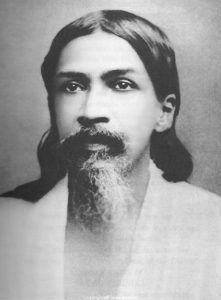 In 1946 Ramaswamy wandered throughout South India as a mendicant. He devised this as a test period. “If there is a God, then God will take care of me.” He took two vows: not to keep any money and not to ask anybody for anything, including food. For four months he wandered wherever his feet took him. During the first three days he had nothing to eat. Eventually he was approached by a man who asked, “Have you eaten? You look hungry.” When Ramu replied that he had not eaten in three days the man hurriedly brought him a meal. When Ramu felt tired he would lie down wherever he was and sleep—sometimes by the side of the road, sometimes on a park bench. He never remained in one area for longer than three days. Often he visited the temples, where he was allowed to sleep on the big verandas and bathe in the ponds. After the morning worship the temple priests distributed food; but Ramu adhered strictly to his vow, never standing in the food line. He would eat only if someone noticed him sitting off to the side and brought him a plate of food. Sometimes walking, sometimes taking advantage of rides that were offered and sometimes traveling by train, Ramu was able to visit Kalahasti, Madras, Calcutta, and Benares.
In 1946 Ramaswamy wandered throughout South India as a mendicant. He devised this as a test period. “If there is a God, then God will take care of me.” He took two vows: not to keep any money and not to ask anybody for anything, including food. For four months he wandered wherever his feet took him. During the first three days he had nothing to eat. Eventually he was approached by a man who asked, “Have you eaten? You look hungry.” When Ramu replied that he had not eaten in three days the man hurriedly brought him a meal. When Ramu felt tired he would lie down wherever he was and sleep—sometimes by the side of the road, sometimes on a park bench. He never remained in one area for longer than three days. Often he visited the temples, where he was allowed to sleep on the big verandas and bathe in the ponds. After the morning worship the temple priests distributed food; but Ramu adhered strictly to his vow, never standing in the food line. He would eat only if someone noticed him sitting off to the side and brought him a plate of food. Sometimes walking, sometimes taking advantage of rides that were offered and sometimes traveling by train, Ramu was able to visit Kalahasti, Madras, Calcutta, and Benares.

Sri Aurobindo
Ramu traveled to Pondicherry in order to have darshan of the great yogi Sri Aurobindo. Born in the city of Calcutta in 1871, Sri Aurobindo Ghose was a poet, philosopher and educator. He was often viewed as controversially political because he spoke out about Indian independence. Behind the outspokenness was a deeply spiritual vision of India, held by a patriot who believed his country should be ruled by Sanatana Dharma (Eternal Law). Sri Aurobindo practiced a rigorous form of sadhana for six years in the hope of perfecting himself in order to selflessly serve his country. Following this period he met an accomplished yogi who gave him further spiritual instruction. After just three days of meditation he had numerous spiritual experiences that transformed his life. He left Calcutta and journeyed to Pondicherry, where eager students joined him. Though the Aurobindo Ashram grew up around him, the great yogi spent most of his time in seclusion, practicing Yoga sadhana. Sri Aurobindo gave darshan only four times a year, but through his writings he gave detailed instructions to his students.
Ramu gratefully received the blessings of the great Master and his foremost disciple, the Mother, then continued his journey through South India as a wandering mendicant.

Recent Comments